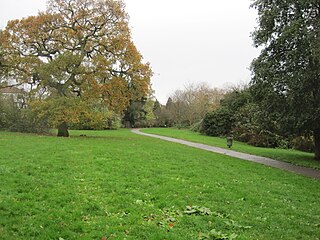
Bocage is a terrain of mixed woodland and pasture characteristic of parts of northern France, southern England, Ireland, the Netherlands, northern Spain and northern Germany, in regions where pastoral farming is the dominant land use.
Over the Edge may refer to:

A hedge or hedgerow is a line of closely spaced shrubs and sometimes trees, planted and trained to form a barrier or to mark the boundary of an area, such as between neighbouring properties. Hedges that are used to separate a road from adjoining fields or one field from another, and are of sufficient age to incorporate larger trees, are known as hedgerows. Often they serve as windbreaks to improve conditions for the adjacent crops, as in bocage country. When clipped and maintained, hedges are also a simple form of topiary.
A hedge is a line of closely spaced shrubs planted to act as a barrier or boundary.
(The) Grey Lady or (The) Gray Lady may refer to:

Hedgelaying is a countryside skill that has been practised for centuries, mainly in the United Kingdom and Ireland, with many regional variations in style and technique. Hedgelaying is the process of partially cutting through and then bending the stems of a line of shrubs or small trees, near ground level, without breaking them, so as to encourage them to produce new growth from the base and create a living ‘stock proof fence’. The first description of hedgelaying is in Julius Caesar's Commentaries on the Gallic War, when his army was inconvenienced by thick woven hedges during the Battle of the Sabis in Belgium. Hedgelaying developed as a way of containing livestock in fields, particularly after the acts of enclosure which, in England, began in the 16th century. Today hedges are laid to contain livestock without the need for artificial fences, maintain biodiversity-friendly habitats, promote traditional skills and because of the pleasing visual effect of a laid hedge.

"Rhino tank" was the American nickname for Allied tanks fitted with "tusks", or bocage cutting devices, during World War II. The British designation for the modifications was Prongs.

A hurdle is a moveable section of light fence. In the United States, terms such as "panel", "pipe panel" or simply "fence section" are used to describe moveable sections of fencing intended for agricultural use and crowd control; "hurdle" refers primarily to fences used as jumping obstacles for steeplechasing with horses or human track and field competition.
Tony or Anthony Ward may refer to:
A taproot is a type of plant root.

Hedgerow Theatre is a theatre company founded in 1923. It is based in Rose Valley, Pennsylvania, United States near Philadelphia. It was "for many years the only true U. S. professional repertory theater." The building is a contributing structure in the Rose Valley Historic District listed on the National Register of Historic Places.

A Devon hedge, also known as a Devon hedgebank, consist of a rubble or earth bank that is usually topped with bushy shrubs forming a hedgerow, with trees also being a frequent and noticeable feature. The bank may be faced with turf or stone.
A stile is a structure such as steps allowing pedestrians to cross a hedge or fence. Stile may also refer to:
Ulmus'Sapporo Gold 2' is an elm cultivar raised by the Wisconsin Alumni Research Foundation (WARF), United States, but only registered and released to commerce in Europe.

Stoneyfields Park is a three-hectare public park in The Hale in the London Borough of Barnet.

Princes Park is a small public park and Site of Local Importance for Nature Conservation in Temple Fortune in the London Borough of Barnet.

Wotton Hill is a hill on the edge of the Cotswold Hills in Gloucestershire, England, 0.5 miles (0.80 km) north of Wotton-under-Edge. The Cotswold Way passes over the hill.
This is a bibliography of hedges and topiary. It includes works relating to the natural history and botany of the hedgerow as well as works relating to the horticultural practice of the creation of topiary, and works relating to the cultivation of Buxus, a plant commonly used to create hedges.
This page is based on this
Wikipedia article Text is available under the
CC BY-SA 4.0 license; additional terms may apply.
Images, videos and audio are available under their respective licenses.









